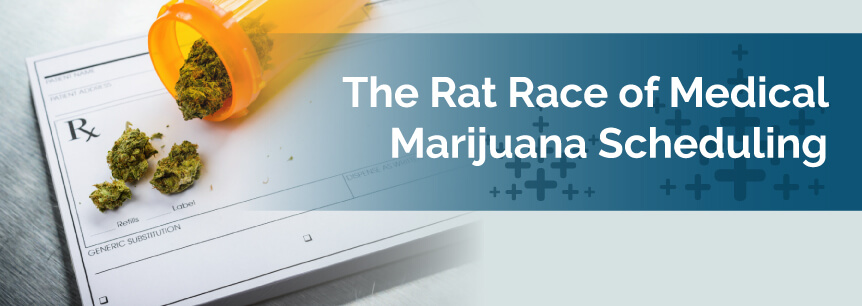
Medical marijuana is currently going through a process of medical and legal evaluations to determine protocols for its use to treat the symptoms of disease. This process is fast and slow at the same time. For patients waiting for the opportunity to ease their pain or improve their health with marijuana therapy, it is much too slow. For entities trying to grab control and eventually profit from the widespread use of medical marijuana, the process may be moving too fast.
The ban on marijuana in this country shares many similarities with Prohibition. Alcohol was once believed to be the enemy of moral and decent people, just like the stigma against marijuana that keeps the ban in place. When the cost of Prohibition was understood, the amendment outlawing alcohol was repealed. Perhaps the health benefits and financial opportunities for some may eventually end the ban on marijuana. Until then, the rat race continues.
The Food and Drug Administration (FDA) is the regulatory agency responsible for the drugs that are available on the market. It determines which ones are accessible to the public and which drugs must be prescribed by a doctor. The FDA also sets prescribing guidelines based on what conditions a drug may be used to treat.
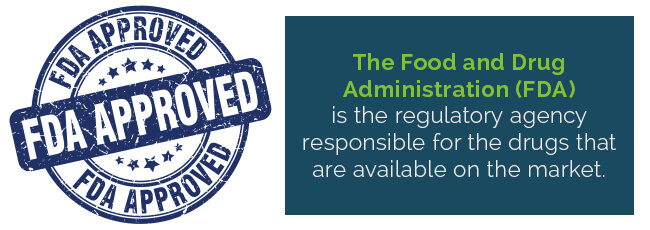
Since its inception, the FDA has attempted to determine the safety of any products brought to market. Its system of evaluation evolved over the years as medical technology and testing techniques advanced. The core mission of the FDA is to evaluate the safety of each new drug and its effectiveness in treating certain conditions.
The law allows a broad interpretation of what tests are required to prove a drug is safe and effective. The testing methods employed and how the results are calculated can be a matter of negotiation. The FDA has latitude to determine on a case-by-case basis what methodology it will accept and what results will prove a particular drug worthy of bringing to market.
Medical marijuana is currently a Schedule I controlled substance just like heroin and ecstasy. Here is a short list of some of the drugs listed by the Drug Enforcement Agency (DEA) as Schedule I:
The DEA considers Schedule I to have a high potential for abuse and little or no medical value. Signed into law by President Nixon in 1970, the Controlled Substance Act (CSA) combined all federal drug laws into one and established the Scheduling system. There are five classifications of controlled substances, and those classifications, or Schedules, are based primarily on potential for abuse and medical value.
CSA makes it easier for the laws to keep up with new substances and for states to regulate drugs. State drug laws refer to Schedules rather than naming individual substances. Drugs can be added to the Schedule without rewriting the entire set of drug laws.
The FDA is responsible for assigning drugs to the Schedules, and the DEA enforces the controlled substance laws. Under CSA, drug manufacturers, importers, exporters and distributors are registered. They are required to keep accurate records of their inventory of all controlled substances and track the movements of those drugs. The DEA may initiate a proceeding to add or remove a drug from the Schedule based on their observations in the field, and it is responsible for enforcing security requirements on entities that deal with controlled substances.
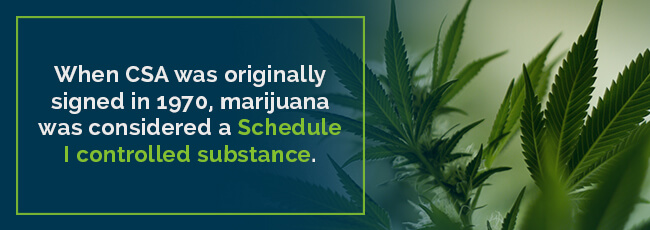
When CSA was originally signed in 1970, marijuana was considered a Schedule I controlled substance. The Department of Health, Education and Welfare made the recommendation based on little testing. It asked Congress to put marijuana in Schedule I based on the fact that it could cause psychological or physical dependence. The scheduling of marijuana was meant to be temporary until certain tests were complete and more information was available.
Marijuana remains a Schedule I controlled substance in 2017, despite several challenges to that status in the intervening decades. Here’s a timeline of those challenges:
The prohibition of marijuana and alcohol in this country started out as social movements. Marijuana was introduced by Mexican immigrants following the Mexican Revolution in the early 1900s. A prohibition on marijuana was politically aimed at controlling the influx of Mexican culture to the States.
Marijuana was quickly linked with the mysterious Mexican culture and demonized. Although cannabis was a popular medicinal additive, the word marijuana was foreign to Americans. It was blamed for bad behaviors and the disruptive nature of these new immigrants. With marijuana against the law, law enforcement had probable cause to stop and search Mexican immigrants.
The prohibition of alcohol was also the result of social fears. Alcohol was around for centuries, and different cultures and religions used it for rituals or demonized it according to their beliefs. In the early 1900s, a social movement began to end domestic violence, political corruption and addiction by outlawing alcohol. Several religious and civic groups joined the crusade that eventually led to the Eighteenth Amendment, which prohibited the transportation, importation, production and sale of alcoholic beverages with a few medical exceptions.
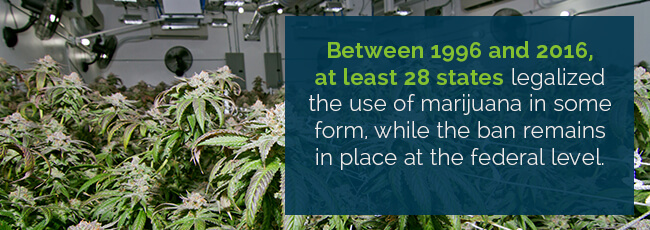
Alcohol prohibition began in the states. By the time the Eighteenth Amendment was passed, many states already had prohibition legislation in place. Ending the prohibition on marijuana is taking the opposite route. Between 1996 and 2016, at least 28 states legalized the use of marijuana in some form, while the ban remains in place at the federal level.
The definition of controlled substance, according to Title 21 of the United States Code governing food and drugs, excludes malt beverages, wine, distilled spirits and tobacco. These substances are regulated by the Internal Revenue Code of 1986 and the 21st Amendment, which repealed prohibition. The states are free to enact their own controls or prohibitions on alcohol and tobacco.
Federal law concerning these substances focuses on the sale and distribution. Licenses and stamps are issued and taxes collected by the government for the transportation and distribution. Any liquor or tobacco sales must be approved by the government to be legal, so the government has a financial incentive in the industry continuing to thrive.
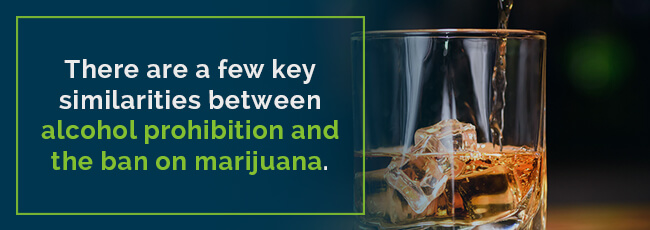
There are a few key similarities between alcohol prohibition and the ban on marijuana. The first and most obvious is enforcement of either ban was and is impossible. During Prohibition, alcohol was still readily available. People who wanted to drink did. The same is true for marijuana. It is not difficult to grow your own plants or find an enterprising person in your community to sell you some marijuana.
Prohibition had organized crime, and so does marijuana. In the case of marijuana, we call them the drug cartels, but they are similar to mob families. It is a rather sophisticated underground organization that produces and distributes what people want. With the ban in place, these crime organizations have no competition except from each other.
And that lack of competition from legal entities means the government cannot collect taxes on these goods when they are banned. The crime families or the drug cartels get to pocket all the profits. The government still has to provide public services, such as law enforcement and hospitals, but there is no revenue coming in from the sale of alcohol or marijuana to help offset those costs.
More money is spent trying to enforce the ban of alcohol or marijuana, and no money is coming in from the sales. There is no evidence enforcement reduced bootlegging during Prohibition, and it is not cutting down on marijuana use today. The use and sale of these commodities is regulated by the market, supply and demand. The government’s attempt to curtail supply does not reduce the demand.
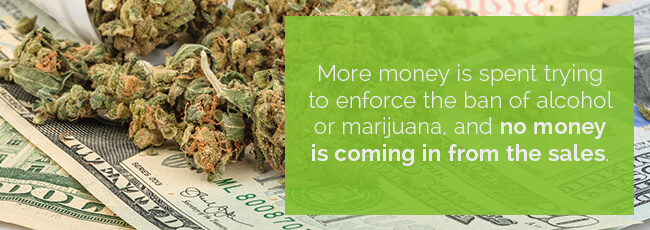
The ban on alcohol and marijuana were both attempts to interfere with personal freedoms couched as matters of public health and safety. Prohibition did not end domestic violence or addiction. It did not even stop some people from drinking. The same is true of the ban on marijuana. Marijuana use remains strong, maybe not quite as strong in the 1970s during the Vietnam War era, but it has not lagged much.
Prohibition did not work. It did not reduce crime or addiction, and it cost the government money. The ban on marijuana is the same. It would make more sense to release marijuana to the controls of doctors with prescription pads, so the people who need it can get the relief they seek. Education is a far better tool against addiction than prohibition.
There is an epic struggle between pharmaceutical companies and proponents of medical marijuana. Big pharma cannot produce marijuana since it is a natural plant. It, instead, has to synthesize drugs to mimic the compounds found in marijuana that are effective at treating disease. If marijuana were legal, people could grow their own medicine, and they wouldn’t need synthetic pharmaceuticals.
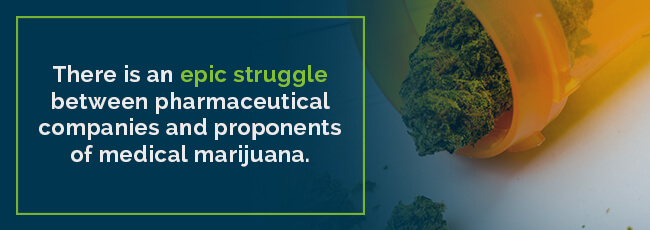
Financial conflict of interest may be at the heart of the issue with legalizing marijuana. Large pharmaceutical companies are racing to develop legal drugs synthesized from components of marijuana. These drugs would compete with medical marijuana if it were legal.
Synthetic drugs designed to mimic the desired effects of marijuana could legally provide the benefits in a form that is accessible to patients. One way around the Schedule I designation of marijuana is to produce a synthetic drug that the FDA will approve for marketing. Several big-name pharmaceutical companies are doing just that. That can create substances to give the same desired effects as marijuana but without the legal ban.
By submitting to the application process at the FDA, pharmaceutical companies can bring their drugs to the market under brand names that do not draw a Schedule I designation. These drugs would compete with medical marijuana if it were legal to grow and use.
Here are some of the pharmaceutical companies with marijuana-based drugs on the market or in research and development:
In states where medical marijuana is legal, the rate of use of prescription painkillers decreased significantly. Medical treatments for other diseases and conditions declined as well. Here is the list of medically treated conditions and how many fewer prescriptions were written in states where medical marijuana is legal:
| Condition | Fewer Doses Prescribed |
| Seizures | 486 |
| Depression | 265 |
| Pain | 1826 |
| Seizures | 486 |
| Nausea | 541 |
| Anxiety | 562 |
| Sleep disorders | 362 |
| Psychosis | 519 |
| Spasticity | 32 |
Pharmaceutical companies are not the only stakeholders in the legalization of marijuana. Making marijuana legal, even if only by prescription, would affect toxicology labs, medical education, treatment programs, insurance companies, patents and trademarks, lobbyists, medical billing and pharmacies. The impact would ripple throughout many medically related industries.
The strongest opponents of legalizing marijuana are those who stand to lose the most. At the top of that list is Big Pharma. The use of medical marijuana would greatly reduce the demand for some of its products, and marijuana is not something it could profit from within the traditional profit model.
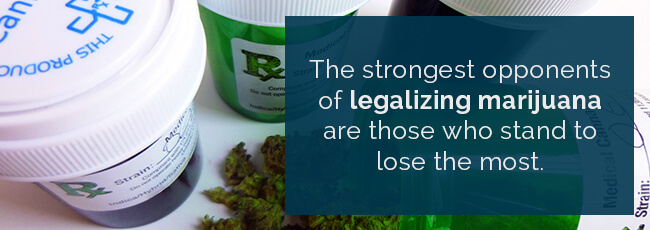
Another loser in the legalization of marijuana will be prison systems. More than half of all drug arrests are for marijuana, and 88 percent of those are simple possession charges. Marijuana possession is often used to establish probable cause to detain or search a person suspected of a bigger crime. A large number of people arrested for marijuana end up serving long prison terms, necessitating the private prison industry, which is likely to lose a lot of business when marijuana is legalized.
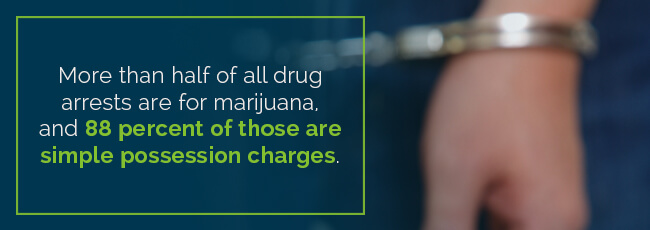
The alcohol industry is also concerned about its profits if marijuana becomes legal. The products it makes are primarily used as recreational drugs. If marijuana use were legal, the liquor industry might lose some of its customers. Some say marijuana produces the same calming effect as alcohol without the hangover. The alcohol industry would certainly face some fierce competition from marijuana if it was competing on equal ground.
PhRMA, which represents all of the major pharmaceutical companies, spent $18 million on lobbying in 2013. In 2012, drug manufacturers gave almost $21.8 million to support candidates who would carry out their agenda. That is a lot of spending, and it shows how much the industry stands to lose if marijuana becomes legal.
Police unions stand to lose federal money in the neighborhood of $2.4 billion if they are no longer charged with finding and arresting people in possession of marijuana. They would also be out a large portion of money in asset forfeitures. Corrections Corporation of America spends around $970,000 every year on lobbying because it knows legalizing marijuana would cut down on their business significantly.
Using the history of alcohol prohibition as a guide, we can assume marijuana will eventually become legal. It is already legal in several states, some of which are pioneering programs to track the use and effectiveness of marijuana for many different conditions.
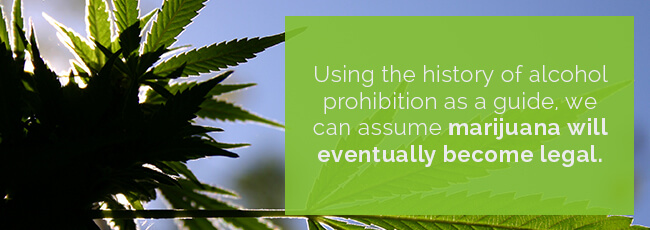
Patients will ultimately be the winners as they are able to relieve their symptoms and improve their health with medical marijuana treatment. Doctors will eventually become the beneficiaries of new means of treating their patients for whom traditional treatments do not work.
The race to secure research data to prove the benefits of marijuana treatment will benefit both the medical industry as a whole and patients as the end users. For years, marijuana was only studied for its psychotropic powers. More modern medical research, in conjunction with a better understanding of brain chemistry, will reveal new uses and health benefits of marijuana.
The study of how marijuana relieves pain that was unaffected by other analgesics, for example, can bring us new protocols for pain management and a better understanding of how pain is processed in the brain. Dissecting the various chemical components of cannabis, mapping their uses, and applying them to different disease states will make it easier to relieve suffering. It may not be a cure for disease, but marijuana certainly makes patients more comfortable and helps them tolerate harsh treatments better.
If you want to learn more about the rat race for medical marijuana scheduling or keep up on the situation with the latest updates, sign up for our newsletter. At Marijuana Doctors, our focus is connecting patients with the marijuana treatment they need to feel better. We provide industry-changing services to help move you into the next generation of health care. We want you to be able to take advantage of innovation in marijuana treatment and laws.
Marijuana scheduling is just one aspect of the marijuana industry we monitor very closely at Marijuana Doctors. We also keep up on the latest in treatment options and legal registry guidelines to be sure you are getting the most accurate information about medical marijuana.
Use our website to search for a medical marijuana doctor in your area or a dispensary. Here you will find the most up-to-date database of marijuana doctors available anywhere. If you have any questions about whether you qualify for medical marijuana or how you can obtain a prescription, contact us. We are here to help you navigate the sometimes-confusing, ever-changing rules for medical marijuana.
No Information on MarijuanaDoctors.Com should be used to diagnose, treat, prevent or cure any disease or condition. You can view our Full Disclaimer here.